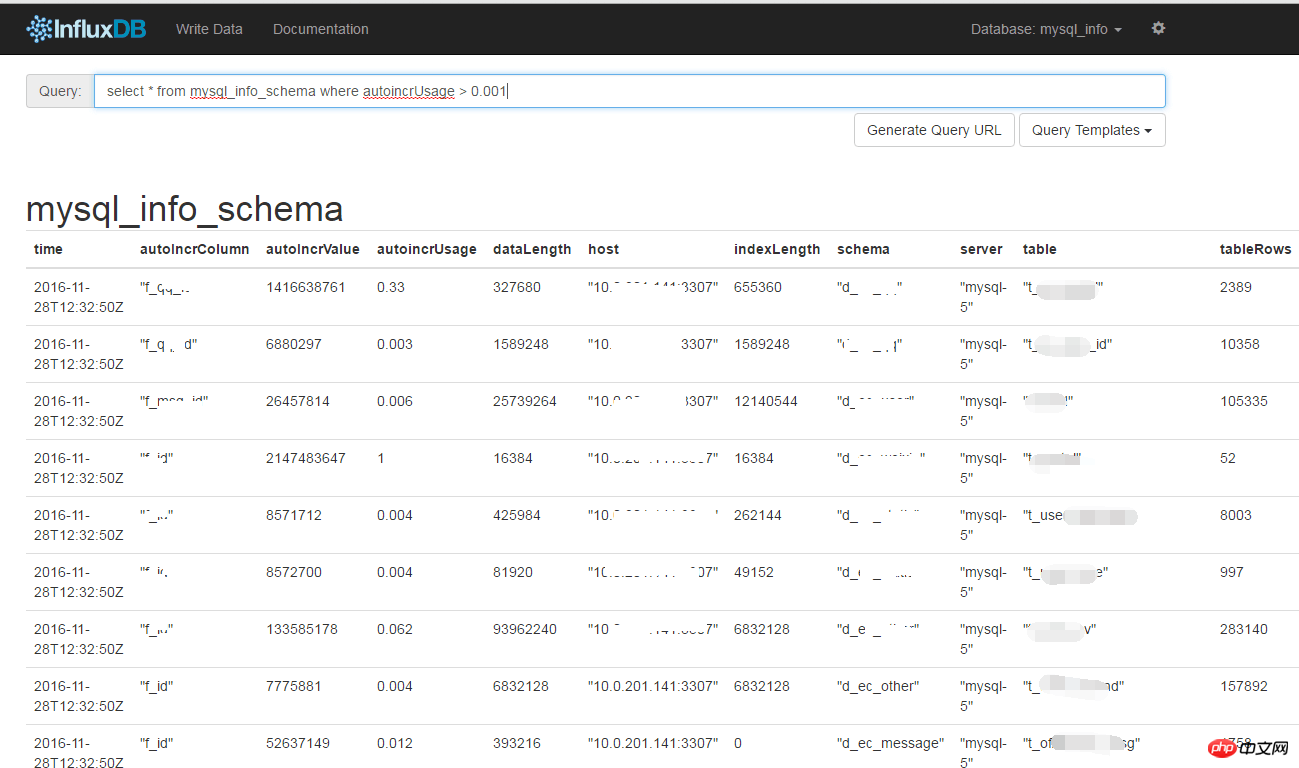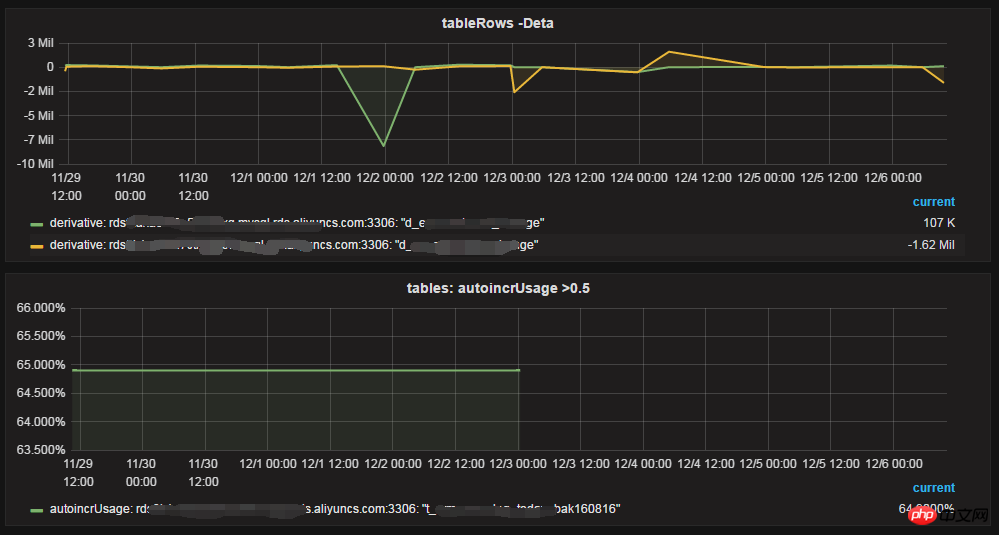 Database
Database
 Mysql Tutorial
Mysql Tutorial
 Detailed explanation of the code for collecting table information while monitoring MySQL (pictures and text)
Detailed explanation of the code for collecting table information while monitoring MySQL (pictures and text)
Detailed explanation of the code for collecting table information while monitoring MySQL (pictures and text)
1. Story
Perhaps you are often asked about the monthly data volume growth of a certain table in the library in the past year. Of course, if you have tables divided by month, it is easier to handle. show table status one by one. If there is only one big table, then you probably have to run SQL statistics in the lonely night when everyone is resting, because you Only the current table information can be obtained, and historical information cannot be traced.
In addition, as a DBA, you must also estimate the growth of database space to plan capacity. The table information we are talking about mainly includes:
Table data size (DATA_LENGTH)
Index size (INDEX_LENGTH)
Number of rows (ROWS)
Current auto-increment value (AUTO_INCREMENT, if any)
I haven’t seen which one yetmysqlMonitoring tools provide such indicators. This information does not need to be collected too frequently, and the result is only an estimate and may not be accurate, so this is to monitor (collect) the table from a global and long-term perspective.
The collection tool I wrote to introduce in this article is based on the existing monitoring system in the group:
InfluxDB: Time series Database, stores monitoring dataGrafana: Data display panelTelegraf: Collect information The agent
took a look at the latest mysql plug-in of telegraf. I was very pleased at first: it supports the collection of Table schema statistics and Info schema auto increment columns. I tried it out and there is data, but as mentioned before, except for the self-increased value, everything else is an estimate. It is meaningless if telegraf collects too frequently. Maybe 2 times a day is enough. TheIntervalSlow## it provides #The option is hard-coded and can only slow down the frequency of global status monitoring. However, it can be implemented by separating it from other monitoring indicators into twoconfiguration files and defining the collection intervals respectively.
The implementation is also very simple, just query the
COLUMNS and TABLES two tables of the information_schema library:
1 2 3 4 5 6 7 8 9 10 11 12 13 14 15 16 17 18 19 20 21 22 23 24 25 26 |
|
auto_increment, in addition to paying attention to where the current growth is, we also care about how much free space is compared to the maximum value of int / bigint. So the autoIncrUsage column was calculated to save the currently used ratio.
json - this is a format commonly supported by monitoring tools such as Zabbix and Open-Falcon.
The last step is to use Grafana to draw pictures from the influxdb data source. 3. Usage- Environment
Written in python 2.7 environment, 2.6 and 3.x have not been tested.
MySQLdb and influxdb:
1 |
|
- Configuration
settings_dbs.pyConfiguration file - ##DBLIST_INFO
: List Store the MySQL instance table information that needs to be collected. The tuples are the connection address, port, user name, and password.
Users need the permission to select the table, otherwise they cannot see the corresponding information.
- InfluxDB_INFO
: Influxdb connection information, please create the database name in advance
mysql_infois set toNone
The output result is json. Create the database and storage strategy on influxdb - Storage for 2 years, 1 replica set: (Adjust as needed)
Look at the big information similar to:1
2
CREATE DATABASE"mysql_info"CREATE RETENTION POLICY"mysql_info_schema"ON"mysql_info"DURATION 730d REPLICATION 1 DEFAULTCopy after login - It can be placed separately on the server used for monitoring, but it is recommended to be used in production The environment can be run on the host where the mysql instance is located, for safety reasons.
In the case of sub-database and table, the global unique ID cannot be calculated in the table autoIncrUsage
It is actually very difficult to implement Simple, the more important thing is to awaken the awareness of collecting this information
You can add Graphite output format

- Put crontab to run
before and after migration to collect it. Not recommended too often. <div class="code" style="position:relative; padding:0px; margin:0px;"><pre class='brush:php;toolbar:false;'>40 23,5,12,18 * * * /opt/DBschema_info/mysql_schema_info.py >> /tmp/collect_DBschema_info.log 2>&1</pre><div class="contentsignin">Copy after login</div></div>
- Table data size and number of rows
##Increment in the number of rows per day, auto_increment usage
4. More
The above is the detailed content of Detailed explanation of the code for collecting table information while monitoring MySQL (pictures and text). For more information, please follow other related articles on the PHP Chinese website!

Hot AI Tools

Undresser.AI Undress
AI-powered app for creating realistic nude photos

AI Clothes Remover
Online AI tool for removing clothes from photos.

Undress AI Tool
Undress images for free

Clothoff.io
AI clothes remover

Video Face Swap
Swap faces in any video effortlessly with our completely free AI face swap tool!

Hot Article

Hot Tools

Notepad++7.3.1
Easy-to-use and free code editor

SublimeText3 Chinese version
Chinese version, very easy to use

Zend Studio 13.0.1
Powerful PHP integrated development environment

Dreamweaver CS6
Visual web development tools

SublimeText3 Mac version
God-level code editing software (SublimeText3)

Hot Topics
 1652
1652
 14
14
 1412
1412
 52
52
 1303
1303
 25
25
 1250
1250
 29
29
 1224
1224
 24
24
 MySQL's Role: Databases in Web Applications
Apr 17, 2025 am 12:23 AM
MySQL's Role: Databases in Web Applications
Apr 17, 2025 am 12:23 AM
The main role of MySQL in web applications is to store and manage data. 1.MySQL efficiently processes user information, product catalogs, transaction records and other data. 2. Through SQL query, developers can extract information from the database to generate dynamic content. 3.MySQL works based on the client-server model to ensure acceptable query speed.
 How to start mysql by docker
Apr 15, 2025 pm 12:09 PM
How to start mysql by docker
Apr 15, 2025 pm 12:09 PM
The process of starting MySQL in Docker consists of the following steps: Pull the MySQL image to create and start the container, set the root user password, and map the port verification connection Create the database and the user grants all permissions to the database
 Laravel Introduction Example
Apr 18, 2025 pm 12:45 PM
Laravel Introduction Example
Apr 18, 2025 pm 12:45 PM
Laravel is a PHP framework for easy building of web applications. It provides a range of powerful features including: Installation: Install the Laravel CLI globally with Composer and create applications in the project directory. Routing: Define the relationship between the URL and the handler in routes/web.php. View: Create a view in resources/views to render the application's interface. Database Integration: Provides out-of-the-box integration with databases such as MySQL and uses migration to create and modify tables. Model and Controller: The model represents the database entity and the controller processes HTTP requests.
 Solve database connection problem: a practical case of using minii/db library
Apr 18, 2025 am 07:09 AM
Solve database connection problem: a practical case of using minii/db library
Apr 18, 2025 am 07:09 AM
I encountered a tricky problem when developing a small application: the need to quickly integrate a lightweight database operation library. After trying multiple libraries, I found that they either have too much functionality or are not very compatible. Eventually, I found minii/db, a simplified version based on Yii2 that solved my problem perfectly.
 Laravel framework installation method
Apr 18, 2025 pm 12:54 PM
Laravel framework installation method
Apr 18, 2025 pm 12:54 PM
Article summary: This article provides detailed step-by-step instructions to guide readers on how to easily install the Laravel framework. Laravel is a powerful PHP framework that speeds up the development process of web applications. This tutorial covers the installation process from system requirements to configuring databases and setting up routing. By following these steps, readers can quickly and efficiently lay a solid foundation for their Laravel project.
 How to install mysql in centos7
Apr 14, 2025 pm 08:30 PM
How to install mysql in centos7
Apr 14, 2025 pm 08:30 PM
The key to installing MySQL elegantly is to add the official MySQL repository. The specific steps are as follows: Download the MySQL official GPG key to prevent phishing attacks. Add MySQL repository file: rpm -Uvh https://dev.mysql.com/get/mysql80-community-release-el7-3.noarch.rpm Update yum repository cache: yum update installation MySQL: yum install mysql-server startup MySQL service: systemctl start mysqld set up booting
 MySQL and phpMyAdmin: Core Features and Functions
Apr 22, 2025 am 12:12 AM
MySQL and phpMyAdmin: Core Features and Functions
Apr 22, 2025 am 12:12 AM
MySQL and phpMyAdmin are powerful database management tools. 1) MySQL is used to create databases and tables, and to execute DML and SQL queries. 2) phpMyAdmin provides an intuitive interface for database management, table structure management, data operations and user permission management.
 Centos install mysql
Apr 14, 2025 pm 08:09 PM
Centos install mysql
Apr 14, 2025 pm 08:09 PM
Installing MySQL on CentOS involves the following steps: Adding the appropriate MySQL yum source. Execute the yum install mysql-server command to install the MySQL server. Use the mysql_secure_installation command to make security settings, such as setting the root user password. Customize the MySQL configuration file as needed. Tune MySQL parameters and optimize databases for performance.



